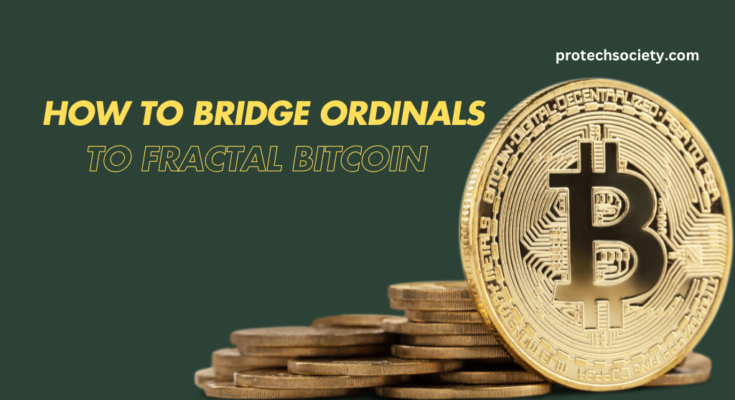Cryptocurrency is changing rapidly, and innovations within Bitcoin’s ecosystem are no exception. One trending topic is learning how to bridge ordinals to fractal Bitcoin. On its face, this process may be complicated. Still, it has the potential for incredible innovation in the changes it can bring to Bitcoin’s functionality and provide an interconnected blockchain environment. This will break down this topic, from the basics to step-by-step, and discuss its implications in the future.
Table of Contents
ToggleWhat Are Bitcoin Ordinals?
Before we explore how to bridge ordinals to fractal Bitcoin, let’s define the term ordinal. Bitcoin ordinals refer to individual satoshis (the smallest unit of Bitcoin)
inscribed with unique data. The process, commonly called “inscription,” transforms each satoshi into a distinct digital artefact, much like NFTs on other blockchains.
Unlike traditional NFTs embedded in smart contracts, bitcoin ordinals are directly put into the blockchain, thus being immutable and secure. Bitcoins have just opened another world by stepping beyond their current role solely as a unit of store of value. Imagine having a unique collectable piece of Bitcoin with a special message or artwork attached, and ordinals make this possible.
What Is Fractal Bitcoin?
First, we need to know what fractal Bitcoin is if we’re going to understand how to bridge ordinals to fractal Bitcoin. Fractal Bitcoin describes layer-2 solutions, also known as sidechains, that enhance Bitcoin’s scalability and functionality. Bitcoin is “fractured” on these platforms into more substantial, manageably-sized units while maintaining its core value and security.
Why Bridge Ordinals to Fractal Bitcoin?
Now, why would you learn how to bridge ordinals to fractal Bitcoin? Here are some significant reasons for it:
Enhanced Utility
Bridging enables you to harness the unique properties of ordinals within a much more scalable framework. This allows you to apply your inscribed satoshis in previously impossible ways, like using them in DeFi applications, games, and other apps.
Improved Scalability
Transactions on Bitcoin’s main chain could be faster and more affordable. Bridging ordinals to fractal Bitcoin allows users to benefit from faster processing times and lower fees, making using ordinals for everyday transactions or complex applications practical.
Cross-Chain Interoperability
Understanding how to bridge ordinals to fractal Bitcoin unlocks interoperability opportunities from multiple blockchain networks that will allow your Bitcoin-based assets to interact with Ethereum, Solana, and other chains, unlocking many new use cases and value streams.
Step-by-Step Guide on How to Bridge Ordinals to Fractal Bitcoin
Here’s a detailed guide on how to bridge ordinals to fractal Bitcoin:
Step 1: Set Up Your Wallet
First, download and install a wallet that supports Bitcoin ordinals. It should be updated to its latest version and secured using a strong password and a backup phrase.
Step 2: Acquire Bitcoin Ordinals
If you do not possess any ordinals, you must acquire them. You can create your own by inscribing data onto satoshis or buying them from a marketplace. Once you have acquired your ordinals, send them to your wallet.
Step 3: Select a Bridging Platform
The next step in bridging ordinals to fractal Bitcoin is selecting a reliable bridging platform. Some platforms specialise in Bitcoin-based bridging, so do your research and read user reviews.
Step 4: Connect Your Wallet
Connect your ordinal wallet to the bridging platform. This usually involves scanning a QR code or linking via a browser extension. Double-check that you are on the right website to avoid phishing traps.
Step 5: Bridging starts
Once connected, select an ordinal you wish to bridge in and choose the destination network (fractal Bitcoin). From here, follow the platform’s instructions regarding the transaction details and pay a small fee.
Step 6: Confirm the transaction
You will now confirm your transaction. Be careful because you can’t undo the transaction once it’s done.
Step 7: Wait for the completion
A bridge can take several minutes to hours, depending on network congestion. After that, your ordinal will be available on the fractal Bitcoin network.

Top Platforms for Bridging Ordinals to Fractal Bitcoin
Several sites support bridging, but certainly not all of them are equal. Here are some of the top options:
Portal Bridge
This is a user-friendly bridge that features low fees. It can support loads of assets and networks, making it a big hit for anyone looking to learn how to bridge ordinals to fractal Bitcoin.
Stacks Bridge
Stacks is the layer-2 solution for Bitcoin, and its service as a bridging solution is highly reliable. It features robust security and a smooth user experience.
Lightning Network Bridges
A few platforms based on Lightning Network are working on bridging capabilities. This is ideal if you want lightning-fast transactions with minimal fees.
Troubleshooting common problems
Here’s how to troubleshoot common problems when bridging:
Failed Transactions
Check your internet connection and ensure enough Bitcoin for transfer fees if the transaction fails. If not, contact the support team of your chosen platform.
Slow Transfers
Bridging may take longer, especially when network congestion is high. However, if a transaction takes longer, contact support for help.
Conclusion
Ordinals to Fractal Bitcoin is a giant leap in blockchain technology. The union of Ordinals and the scaling of Fractal Bitcoin delivers new possibilities for innovation, security, and efficiency. Whether developer, investor, or blockchain enthusiast, there is a great understanding and leverage of this very new process that can ultimately open doors to really thrilling opportunities within the Bitcoin ecosystem.
This bridging protocol will play a crucial role in forming the future of decentralised systems as the blockchain landscape continues to evolve. Individuals can join this revolutionary development with the right tools, knowledge, and practices.
FAQs
What are Bitcoin ordinals?
Bitcoin ordinals are unique satoshis inscribed with data, making them digital artefacts or NFTs.
How does bridging work?
Bridging allows transferring assets from one blockchain to another, thus increasing their utility and interoperability.
Are ordinals safe to bridge?
Yes, although a platform’s security is up to the place. Always use reputable services and follow best practices.
Which kind of fees are involved in bridging?
Fees vary by platform but generally include transaction fees and service charges.
Read more about PeopleTools ATT




